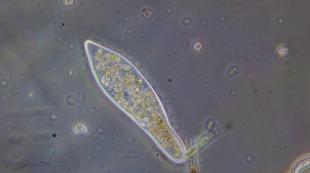Molecular weights of all chemicals. Relative molecular weight. What have we learned
Atoms and molecules are the smallest particles of matter, therefore, as a unit of measurement, you can choose the mass of one of the atoms and express the masses of other atoms in relation to the selected one. So what is molar mass, and what is its dimension?
What is molar mass?
The founder of the theory of atomic masses was the scientist Dalton, who compiled a table of atomic masses and took the mass of a hydrogen atom as a unit.
Molar mass is the mass of one mole of a substance. A mole, in turn, is the amount of a substance that contains a certain amount of the smallest particles that participate in chemical processes. The number of molecules in one mole is called Avogadro's number. This value is constant and does not change.

Rice. 1. Avogadro's number formula.
Thus, the molar mass of a substance is the mass of one mole, in which there are 6.02 * 10^23 elementary particles.
Avogadro's number got its name in honor of the Italian scientist Amedeo Avagadro, who proved that the number of molecules in equal volumes of gases is always the same.
Molar mass in the International SI system is measured in kg / mol, although this value is usually expressed in grams / mol. This value is denoted by the English letter M, and the molar mass formula is as follows:
where m is the mass of the substance and v is the amount of the substance.

Rice. 2. Calculation of the molar mass.
How to find the molar mass of a substance?
The table of D. I. Mendeleev will help to calculate the molar mass of a substance. Take any substance, for example, sulfuric acid. Its formula is as follows: H 2 SO 4. Now let's turn to the table and see what is the atomic mass of each of the elements that make up the acid. Sulfuric acid consists of three elements - hydrogen, sulfur, oxygen. The atomic mass of these elements, respectively, is 1, 32, 16.
It turns out that the total molecular weight is 98 atomic mass units (1 * 2 + 32 + 16 * 4). Thus, we found out that one mole of sulfuric acid weighs 98 grams.
The molar mass of a substance is numerically equal to the relative molecular mass if structural units substances are molecules. The molar mass of a substance can also be equal to the relative atomic mass if the structural units of the substance are atoms.
Until 1961, the oxygen atom was taken as an atomic mass unit, but not the whole atom, but its 1/16 part. At the same time, chemical and physical unit masses were not the same. The chemical one was 0.03% more than the physical one.
At present, a unified measurement system has been adopted in physics and chemistry. As a standard e.a.m. 1/12 of the mass of the carbon atom is chosen.

Rice. 3. Formula of the unit of atomic mass of carbon.
The molar mass of any gas or vapor is very easy to measure. It is enough to use control. The same volume of a gaseous substance is equal in quantity to another at the same temperature. A known way to measure the volume of steam is to determine the amount of displaced air. This process is carried out using a side outlet leading to the measuring device.
The concept of molar mass is very important in chemistry. Its calculation is necessary for the creation of polymer complexes and many other reactions. In pharmaceuticals, the concentration of a given substance in a substance is determined using molar mass. Also, the molar mass is important in the provision of biochemical studies (the exchange process in the element).
Nowadays, thanks to the development of science, the molecular weights of almost all blood components, including hemoglobin, are known.
What have we learned?
In the 8th grade in chemistry, an important topic is the "molar mass of a substance." Molar mass is an important physical and chemical concept. Molar mass is a characteristic of a substance, the ratio of the mass of a substance to the number of moles of this substance, that is, the mass of one mole of a substance. it is measured in kg/mol or gram/mol.
Topic quiz
Report Evaluation
Average rating: 4.2. Total ratings received: 331.
It is no secret that chemical signs allow you to depict the composition of a complex substance in the form of formulas.
Chemical formula- this is a conditional record of the composition of a substance by means of chemical signs and indices.
Formulas distinguish between molecular, structural, electronic and others.
Molecular formulas(H3P04, Fe203, A1 (OH) 3, Na2S04, 02, etc.) show a qualitative (i.e. what elements the substance consists of) and quantitative (i.e. how many atoms of each element are in the substance) composition.
Structural formulas show the order of connection of atoms in a molecule, connecting the atoms with dashes (one dash - one chemical bond between two atoms in the molecule).
Relative atomic and molecular mass
Relative atomic mass a substance or element is a dimensionless quantity. Why is it dimensionless, because the mass must have a dimension?
The reason is that the atomic mass of a substance in kg is very small and is expressed in the order of 10 to the minus 27 power. In order not to take into account this indicator in the calculations, the mass of each element was reduced to a ratio of 1/12 of the mass of the carbon isotope. For this reason, the relative atomic mass of carbon is 12 units.
Modern values of relative atomic masses are given in the periodic system of elements of D.I. Mendeleev. For most elements,
Arithmetic mean values of atomic masses of a natural mixture of isotopes of these elements.
For example, the relative mass of hydrogen is 1 and oxygen is 16.
The relative molecular mass of simple and complex substances is numerically equal to the sum of the relative atomic masses of the atoms that make up the molecule.
For example, the relative molecular weight of water, consisting of two hydrogen atoms and one oxygen atom, is
The chemical formula can be used to calculate both the chemical composition and the molecular weight.
The quantitative composition determined by chemical formulas is of great importance for numerous calculations that are made according to the chemical composition.
The calculation of the relative molecular mass of a substance according to the chemical formula is carried out by adding the products of the relative atomic masses of the elements by the corresponding indices in the chemical formula.
How the molecular weight of a substance is calculated, we considered a little higher.
And it is this task that our chemical calculator automates.
Knowing the molecular weight of a substance, it costs nothing for us to calculate the molar mass.
mole is the amount of matter in a system containing the same amount structural elements how many atoms are there in 12 grams of carbon-12
Thus, the molar mass of a substance corresponds exactly to the relative molecular mass and has the dimension of grams / mol
Thus the molar mass of water is 18 grams/mol.
The molar mass of a substance can be defined as the ratio mass of a given portion of a substance To amount of substance in this portion
Distinctive features
In relation to other calculators that calculate the molar mass of a substance, this calculator has the following features:
The formula can contain parentheses for example
The formula may contain a coefficient
If there is a need to calculate the mass fractions of each chemical element in the formula, then you should use the calculator Mass fraction of a substance online
What molar masses chemical elements not rounded?
It is logical to assume if you read where the concept of "relative mass" comes from, that "not rounded" mass will be in one element - carbon . Will there be other chemical elements with "non-rounded" masses? I doubt.
syntax
molar formula[!]
where formula is an arbitrary formula of a chemical.
Attention! Chemical elements in the formula must be indicated as in the periodic table.
a simple example will show what the cost of an error is not to respect the case (uppercase or lowercase characters) of letters
If we write CO, then this is carbon and oxygen, and if we write Co, then this is cobalt.
In any part of the formula, you can insert a service symbol (exclamation point).
What does he give us?
It rounds all parameters down to the level of accuracy that is used in school curriculum. This is very convenient for those who solve school problems.
For example, the molar mass of water in school textbooks is 18, and if we take into account more accurate algorithms, we get that the molar mass is 18.01528. The difference is small, but if you do a calculation, for example, the mass fraction of a chemical, you get a small but very unpleasant discrepancy in the output parameters, which can mislead inexperienced users of the calculator.
Examples
writing a request molar NaMgU3O24C18H27
we get an answer
If we write an exclamation mark in the input parameters, we get the following answer
The masses of atoms and molecules are very small, so it is convenient to choose the mass of one of the atoms as a unit of measurement and express the masses of the remaining atoms relative to it. This is exactly what the founder of the atomic theory Dalton did, who compiled a table of atomic masses, taking the mass of a hydrogen atom as a unit.
Until 1961, in physics, 1/16 of the mass of an oxygen atom 16 O was taken as an atomic mass unit (abbreviated amu), and in chemistry - 1/16 of the average atomic mass of natural oxygen, which is a mixture of three isotopes. The chemical mass unit was 0.03% larger than the physical one.
Atomic mass and relative atomic mass of an element
At present, a unified measurement system has been adopted in physics and chemistry. 1/12 of the mass of the carbon atom 12 C is chosen as the standard unit of atomic mass.
1 amu \u003d 1/12 m (12 C) \u003d 1.66057 × 10 -27 kg \u003d 1.66057 × 10 -24 g.
DEFINITION
Relative atomic mass of an element (A r)- this is a dimensionless quantity equal to the ratio of the average mass of an element atom to 1/12 of the mass of an atom 12 C.
When calculating the relative atomic mass, the abundance of isotopes of elements in the earth's crust is taken into account. For example, chlorine has two isotopes 35 Cl (75.5%) and 37 Cl (24.5%). The relative atomic mass of chlorine is:
A r (Cl) \u003d (0.755 × m (35 Cl) + 0.245 × m (37 Cl)) / (1/12 × m (12 C) = 35.5.
From the definition of relative atomic mass it follows that the average absolute mass of an atom is equal to the relative atomic mass times the amu:
m(Cl) = 35.5 × 1.66057 × 10 -24 = 5.89 × 10 -23 g.
Relative molecular weight of an element
DEFINITION
Relative molecular weight of the substance (M r)- this is a dimensionless quantity equal to the ratio of the mass of a molecule of a substance to 1/12 of the mass of an atom 12 C.
The relative molecular mass of a molecule is equal to the sum of the relative atomic masses of the atoms that make up the molecule, for example:
M r (N 2 O) = 2×A r (N) + A r (O) = 2×14.0067 + 15.9994 = 44.0128.
The absolute mass of a molecule is equal to the relative molecular mass times the amu.
The number of atoms and molecules in ordinary samples of substances is very large, therefore, when characterizing the amount of a substance, a special unit of measurement is used - the mole.
A mole is the amount of a substance that contains as many particles (molecules, atoms, ions, electrons) as there are carbon atoms in 12 g of the 12 C isotope.
The mass of one 12 C atom is 12 amu, so the number of atoms in 12 g of the 12 C isotope is:
N A \u003d 12 g / 12 × 1.66057 × 10 -24 g \u003d 1 / 1.66057 × 10 -24 \u003d 6.0221 × 10 -23.
Thus, a mole of a substance contains 6.0221×10 -23 particles of this substance.
The physical quantity N A is called the Avogadro constant, it has the dimension = mol -1. The number 6.0221×10 -23 is called Avogadro's number.
DEFINITION
Molar mass (M) is the mass of 1 mole of a substance.
It is easy to show that the numerical values of the molar mass M and the relative molecular mass M r are equal, however, the first value has the dimension [M] = g/mol, and the second is dimensionless:
M = N A × m (1 molecules) = N A × M r × 1 a.m.u. = (N A ×1 amu) × M r = × M r .
This means that if the mass of a certain molecule is, for example, 44 amu, then the mass of one mole of molecules is 44 g.
Avogadro's constant is a proportionality factor that provides a transition from molecular to molar ratios.
One of the basic units in the International System of Units (SI) is the unit of quantity of a substance is the mole.
mole – this is such an amount of a substance that contains as many structural units of a given substance (molecules, atoms, ions, etc.) as there are carbon atoms in 0.012 kg (12 g) of a carbon isotope 12 WITH .
Given that the value of the absolute atomic mass for carbon is m(C) \u003d 1.99 10 26 kg, you can calculate the number of carbon atoms N A contained in 0.012 kg of carbon.
A mole of any substance contains the same number of particles of this substance (structural units). The number of structural units contained in a substance with an amount of one mole is 6.02 10 23 and called Avogadro's number (N A ).
For example, one mole of copper contains 6.02 10 23 copper atoms (Cu), and one mole of hydrogen (H 2) contains 6.02 10 23 hydrogen molecules.
molar mass(M) is the mass of a substance taken in an amount of 1 mol.
The molar mass is denoted by the letter M and has the unit [g/mol]. In physics, the dimension [kg/kmol] is used.
In the general case, the numerical value of the molar mass of a substance numerically coincides with the value of its relative molecular (relative atomic) mass.
For example, the relative molecular weight of water is:
Mr (H 2 O) \u003d 2Ar (H) + Ar (O) \u003d 2 ∙ 1 + 16 \u003d 18 a.m.u.
The molar mass of water has the same value, but is expressed in g/mol:
M (H 2 O) = 18 g/mol.
Thus, a mole of water containing 6.02 10 23 water molecules (respectively 2 6.02 10 23 hydrogen atoms and 6.02 10 23 oxygen atoms) has a mass of 18 grams. 1 mole of water contains 2 moles of hydrogen atoms and 1 mole of oxygen atoms.
1.3.4. The relationship between the mass of a substance and its quantity
Knowing the mass of a substance and its chemical formula, and hence the value of its molar mass, one can determine the amount of a substance and, conversely, knowing the amount of a substance, one can determine its mass. For such calculations, you should use the formulas:
where ν is the amount of substance, [mol]; m is the mass of the substance, [g] or [kg]; M is the molar mass of the substance, [g/mol] or [kg/kmol].
For example, to find the mass of sodium sulfate (Na 2 SO 4) in the amount of 5 mol, we find:
1) the value of the relative molecular weight of Na 2 SO 4, which is the sum of the rounded values of the relative atomic masses:
Mr (Na 2 SO 4) \u003d 2Ar (Na) + Ar (S) + 4Ar (O) \u003d 142,
2) the value of the molar mass of the substance numerically equal to it:
M (Na 2 SO 4) = 142 g/mol,
3) and, finally, a mass of 5 mol of sodium sulfate:
m = ν M = 5 mol 142 g/mol = 710 g
Answer: 710.
1.3.5. The relationship between the volume of a substance and its quantity
Under normal conditions (n.o.), i.e. at pressure R , equal to 101325 Pa (760 mm Hg), and temperature T, equal to 273.15 K (0 С), one mole of various gases and vapors occupies the same volume, equal to 22.4 l.
The volume occupied by 1 mole of gas or vapor at n.o. is called molar volumegas and has the dimension of a liter per mole.
V mol \u003d 22.4 l / mol.
Knowing the amount of gaseous substance (ν ) and molar volume value (V mol) you can calculate its volume (V) under normal conditions:
V = ν V mol,
where ν is the amount of substance [mol]; V is the volume of the gaseous substance [l]; V mol \u003d 22.4 l / mol.
Conversely, knowing the volume ( V) of a gaseous substance under normal conditions, you can calculate its amount (ν) :









